The Solution: Learning To Support The Healing Cycle of the Cell and Nervous System
The Bear Protocol is focused on providing the needs of those who have chronic illnesses that occur when the cell is under stress or in what has been termed as the Cell Danger Response.
What does it mean for a cell to be under stress?
A cell is under stress whenever the burdens of the cell become greater than the cell’s capacity to process the given burden in an effective and healthy way.
For example, when the number of toxic free radicals within the cell becomes greater than the amount of glutathione or antioxidants that can neutralize or process the toxins – the cell enters a state of stress.
This balance is carefully measured and monitored by the mitochondria in every cell of the body.
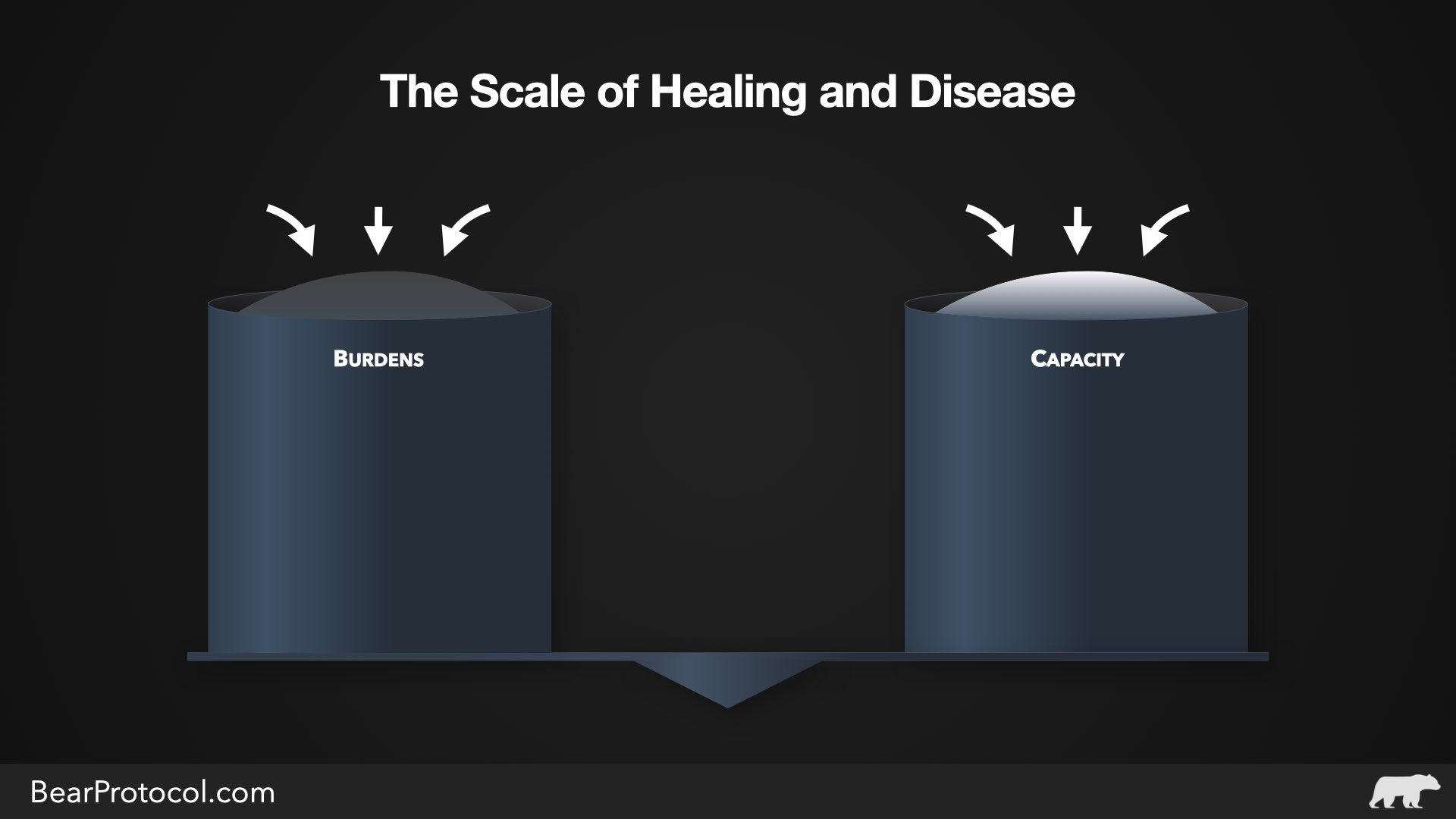
The mitochondria themselves generate a lot of the burden that needs processing. These toxic metabolites are part of the result of the production of energy or ATP, but many lifestyle and environmental factors can also contribute to the burdens and capacity of the cell.
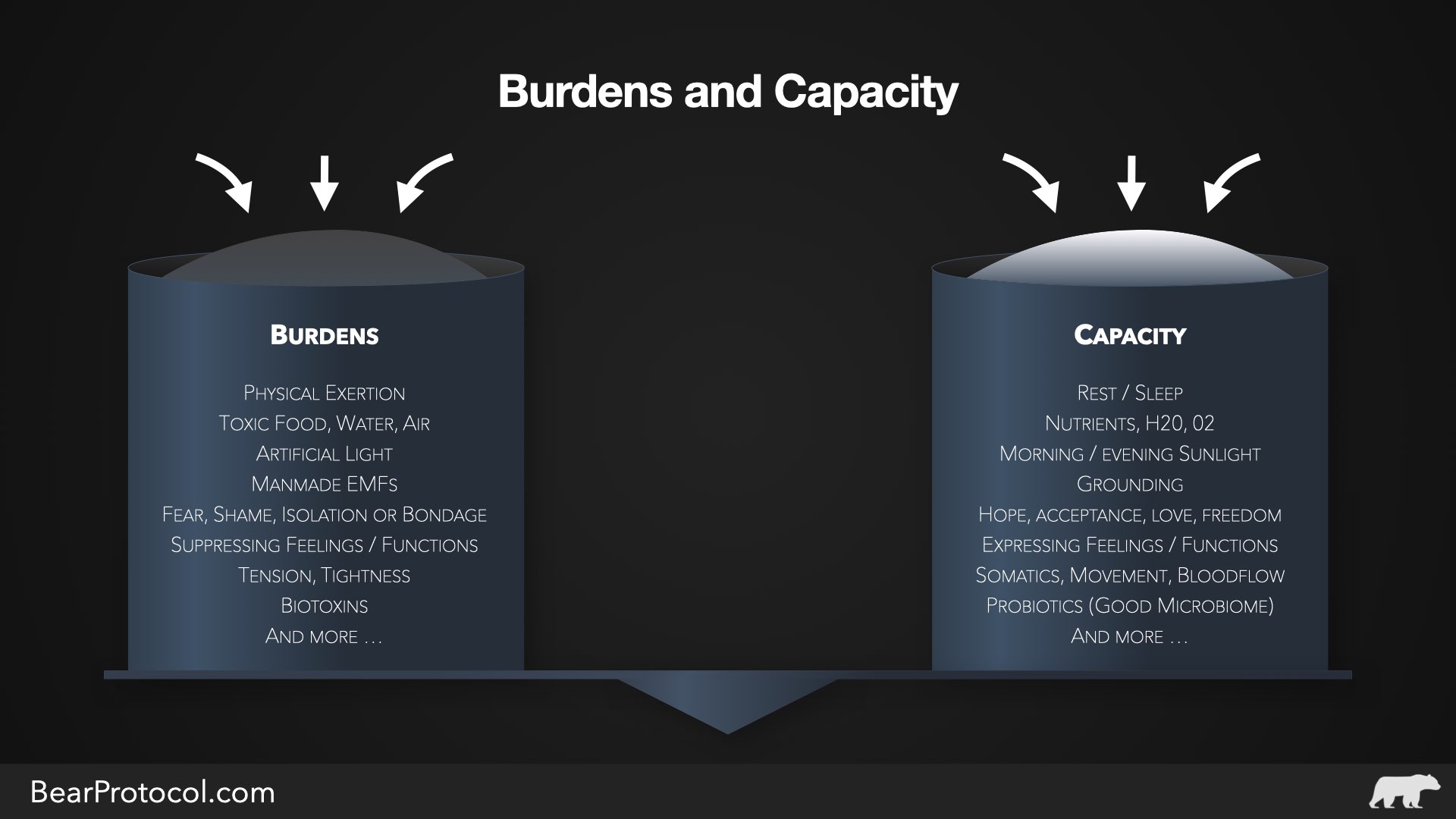
When the mitochondria sense that the scale has tipped towards a greater burden than capacity a cascade of changes is triggered.
This reaction is called the ‘Cell Danger Response’.
Among the first actions of this response is that the mitochondria quit the production of energy / ATP and signals to the nucleus of the cell to alter its behaviors and functions.
As part of changing the cell’s functions, the nucleus turns off several active genes and turns on a new group of genes needed to respond to danger and stress.
You don’t want your cells to remain in this altered state because it is not sustainable or healthy long term. Not only do cells begin to age when the scale tips but when enough cells stop the optimal function at the same time you’ll get symptoms or disease. And as long as the cells remain in this unideal state chronic illness will remain and the body will not return to its proper function.

On the other hand, if the burdens placed on the cell are eliminated and/or slowed or the cell is given enough support and capacity to manage the current burdens – the cell can advance through the healing process and return to a healthy and optimal state.
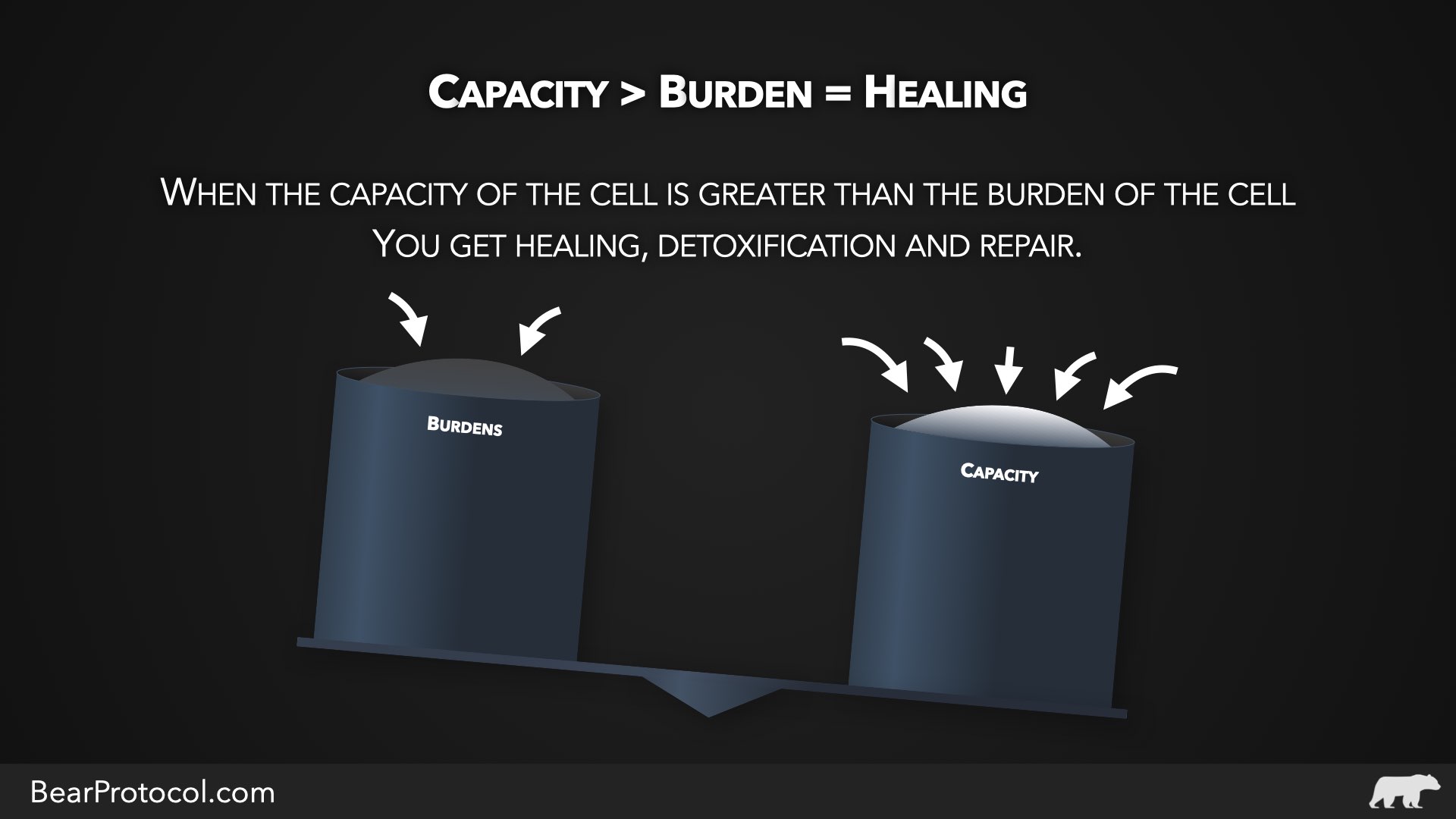
So there remains a REALLY important question.
How does the cell return to a state of health and optimal disease-free function?
or
How can we tip the scale back in favor of capacity and health?

There are four specific phases that the mitochondria and cells pass through. This process is sequential and must be done in order.
Phase 1 of Cellular Healing: Slow and Eliminate The Burden
The first phase of cellular healing is to slow and/or eliminate the cellular burden. Some of the key objectives in this phase of The Bear Protocol include:
- Reduce exposure to unclean air
- Reduce consumption of unclean water
- Reduce consumption of unclean or burdensome foods
- Reduce exposure to artificial light and artificial blue light
- Reduce exposure to manmade EMFs
- Support the synthesis of healthy cell membranes (via lipid and tocotrienol therapy)
- Support the synthesis of healthy mitochondrial membranes (via lipid and tocotrienol therapy)
- Support the downregulation of the freeze response and the dorsal vagal nerve
- Support the upregulation of neuroplasticity
As you implement the therapies of the first phase of healing you can notice any of several physical or emotional changes, including:
- Lessening inflammation
- Lessening allergies
- Lessening asthma
- Lessening in ‘flares’, ‘waves’, ‘attacks’, or ‘episodes’ of reactions to foods, chemicals, or stress
- Lessening of feeling disconnected, disembodied, or socially disengaged
- Increase in feeling connected, embodied, or socially engaged
- Less rigidity, depression, hopelessness
An increased feeling of hopefulness is a signal that the cells and nervous system are moving into phase 2.

Phase 2 of Cellular Healing: Improve Capacity Potential
In the second phase of healing the focus shifts to improving the ability to generate capacity. In short, this means either increasing the number of cells and mitochondria or improving the function of existing cells and mitochondria.
Some of the key objectives include:
- Implementing a sustainable intermittent fasting practice
- Adopting The Bear Diet
- Optimizing amino acid consumption (for glutathione and neurotransmitter synthesis)
- Implementing a sustainable High-Intensity Interval Training (HIIT) practice
- Practicing cold exposure therapy and cold water immersion therapy
- Downregulating the fight and flight response
- Reducing and eliminating as much stress, shame, fear, or isolation as possible
In this phase one can notice any of several changes, including:
- Lower blood glucose
- Less “crashes”
- Lower blood pressure
- Lower weight
- Lower anxiety
- Lower irritability
Feeling a greater sense of safety and freedom is a signal that your body is moving into phase 3.

Phase 3 of Cellular Healing: Fill and Restore Reserves
In the third phase of healing the priority moves to resting up and allowing the body, cells and nervous system to restore depleted resources in preparation for healing, detoxification and repair (which comes in phase 4).
Objectives in phase 3 include:
- Remineralization and mineral optimization
- Learning and implementing pandiculation, Yin Yoga, and breathwork
- Releasing tension and trauma in the muscles and connective tissues (facia, tendons, ligaments)
- Releasing tension and trauma from the nervous system (via breathwork)
- Increasing circulation
- Decreasing artificial blue light exposure
- Optimizing sleep and circadian rhythm
When you’re beginning to feel strong and energized your body is about to move into the fourth phase.
Quick Note! Don’t take this energy and go use it up on exercise or taking on stressful tasks. Rather, understand that your body is finally reaching a point where reserves are nearly restored and if you continue to rest and restore your body will all on its own accord move into a detoxification and healing state. This is what you’ve been working towards so don’t misuse this opportunity for healing!
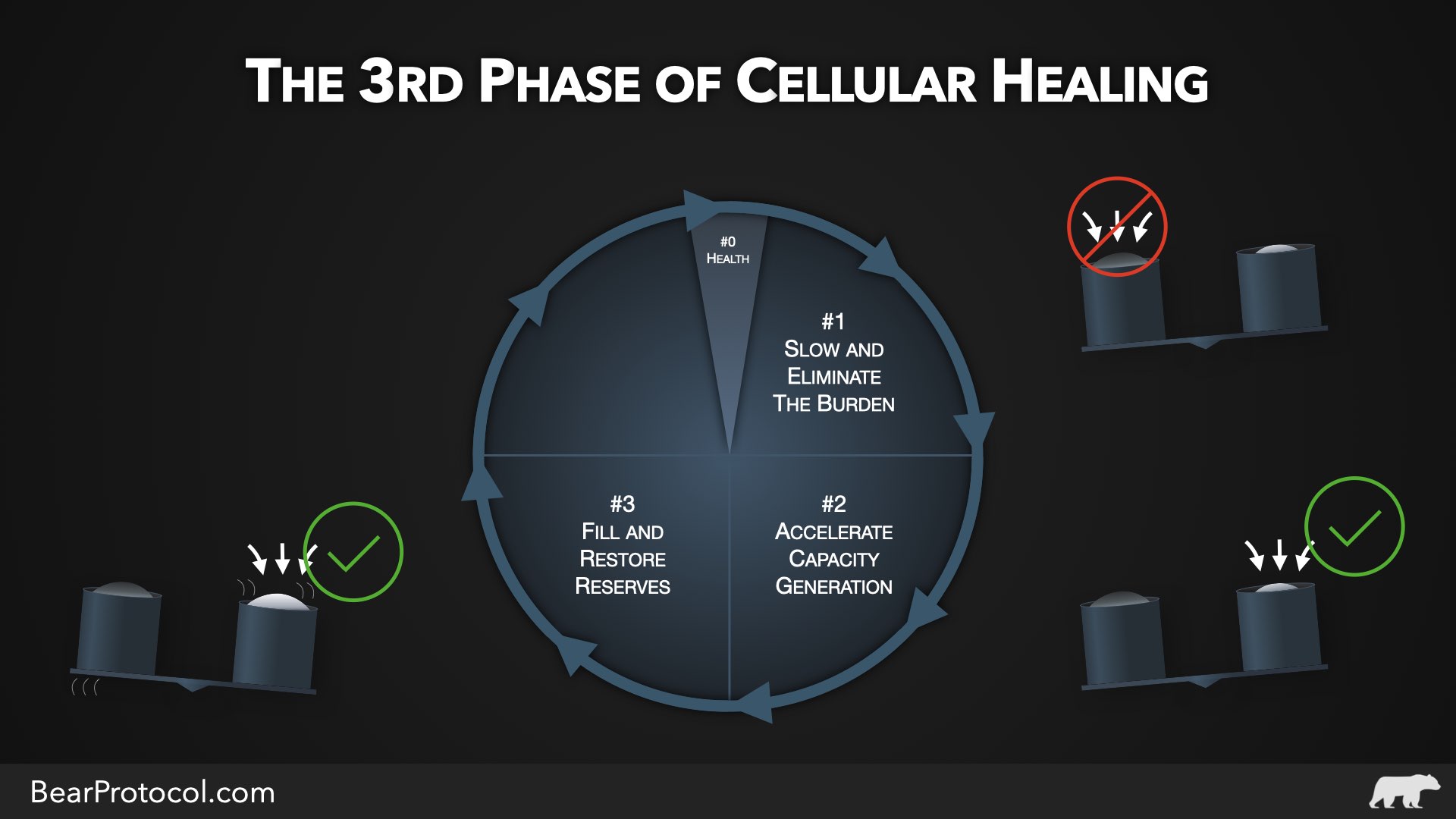
Phase 4 of Cellular Healing: Detoxification and Repair
The fourth and final phase of healing is the detoxification and repair phase. Here the cell finally has the toxins contained and has the necessary resources available to package and send away the toxins and repair the damages made by the toxin.
Note that symptoms can turn worse in this phase as the body dumps toxins. This is something that happens naturally when the body is in a high-capacity state where it is ready and can handle the detoxification process.
Symptoms might include:
- Headaches
- Body odors
- Body aches and chills
- Involuntary shaking
- Sweating
- Virus-like symptoms
- Trauma releases
- Heightened spiritual experiences
Some of the objectives in this phase include:
- Vitamin optimization and/or therapy
- Sunlight therapy
- Grounding
- Binders
- Biofilm disrupting support
- Sweating
- Juicing
- Music, Singing, Dancing
- Connecting with others
- Self-discovery of gifts, talents, and purpose
- Creative activities
- Compassion and lifting others
Please note that the wave of unpleasant detoxification symptoms can come several times before they subside in intensity but this is different for everyone. Some people may only need one big detox while others may go through several “detoxes” or “healing crises” (as they are sometimes called) before they subside.
Also, note that just because detoxification subsides does not mean that all the injury and damage has been healed. Depending on the type of illness or injury it can be months or years before everything in the body has been completely healed and made new. For example, in the case of mold exposure, where one has maybe lived in a moldy home, it can take two years of dedicated healing lifestyle before all of the inflammation and damaged nerves have been fully repaired.

Let’s Summarize The Sequence of Mitochondrial and Cellular Healing
Okay, let’s summarize what we now know about the four-phase sequence of cellular healing.
- The first goal of the cell is to contain the threat … (or stop toxins and burdens from overfilling the burden bucket).
- The second goal of the cell is to increase capacity potential by creating new and more mitochondria … (or building a larger ‘capacity’ bucket so that a higher available capacity can be attained).
- The third goal of the cell is to fully restore capacity levels or even fill capacity levels to a new higher potential capacity as needed to resolve the injury and damages taken … (or fill the capacity bucket).
- The fourth and final goal of the cell is to completely heal and remodel any injury back to its proper and perfect form/function and remove and eliminate any remaining toxins … (or empty the ‘burden’ bucket).
If you’d like a little extra detail of the attributes and characteristics of the four phases of cellular healing consider this table here. While you don’t need to understand all the details of this table it may be helpful to note that there are specific therapies that help during each phase of cellular healing.
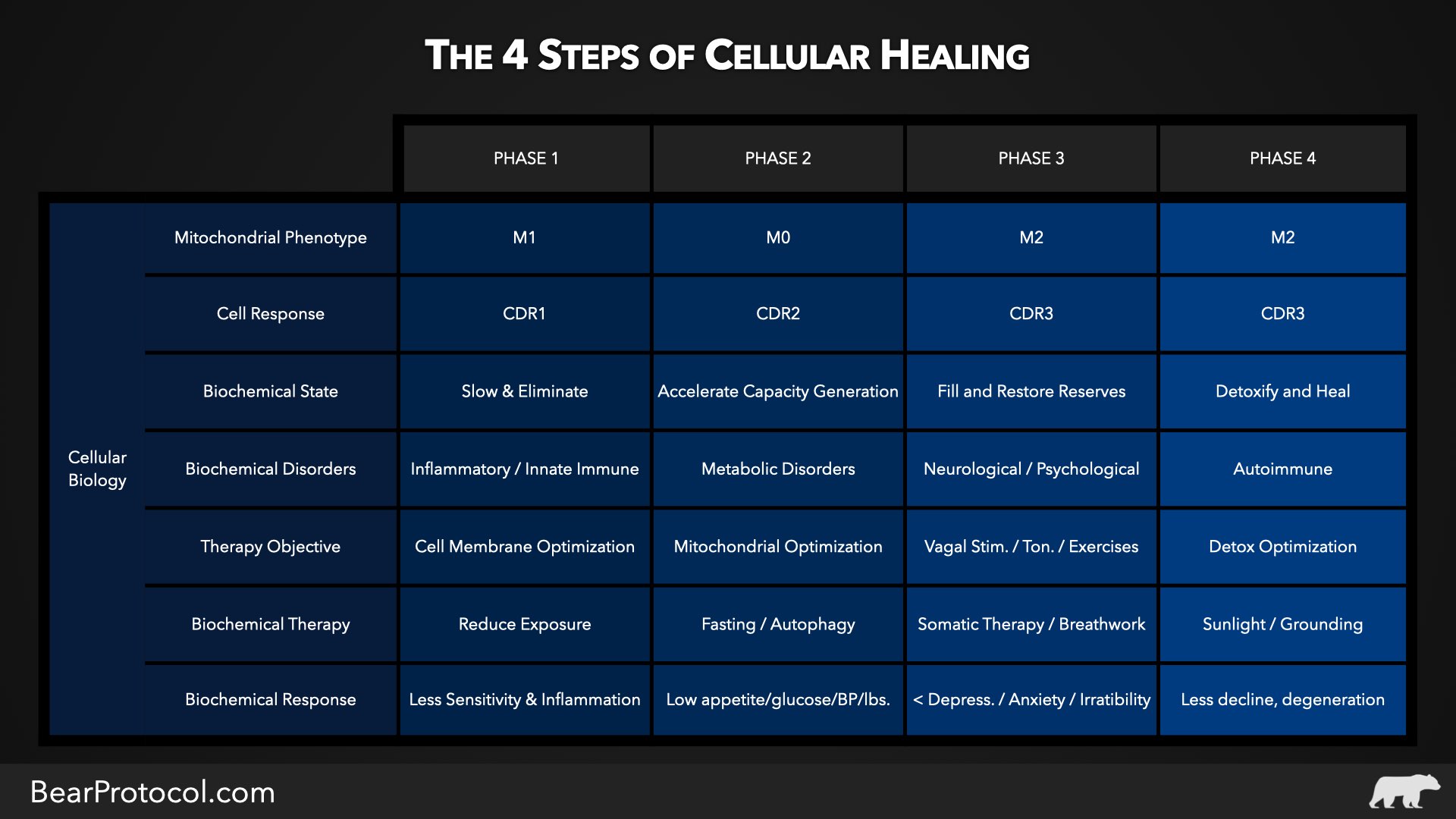
Okay, as long as we understand those four points of cellular and/or mitochondrial healing, let’s move into and simplify a second issue ABSOLUTELY CRITICAL to healing chronic illness.
The 4 States of The Nervous System
The cell isn’t the only part of the body that enters a survival and healing sequence when presented with a threat. The nervous system also enters a survival response. And, like the cell, the nervous system passes through four phases before returning to optimal function. It should be carefully noted that the 4 phases ARE NOT completely unrelated – they do in fact impact one another. Cellular therapy can often come up short because nervous system healing is not addressed and nervous system therapy can often fail because it does not address cellular healing.
Nervous system states can be divided into thriving vs survival states and also into conserving vs exerting states.
When the body is presented with danger, threat, and stress – the survival states are activated or more active. These states are often referred to as the fight and flight state and the freeze and fawn state. When the body is free of danger or has recovered from the survival states – the thriving states are activated or more active. These states are often referred to as the rest and digest (rest and restore) state and the flow state.

As noted the nervous system states can also be divided into states where the body is conserving energy and states where it is expending energy. When the body is conserving energy the parasympathetic nervous system is more active. And when the body is exerting energy the sympathetic nervous system is more active.
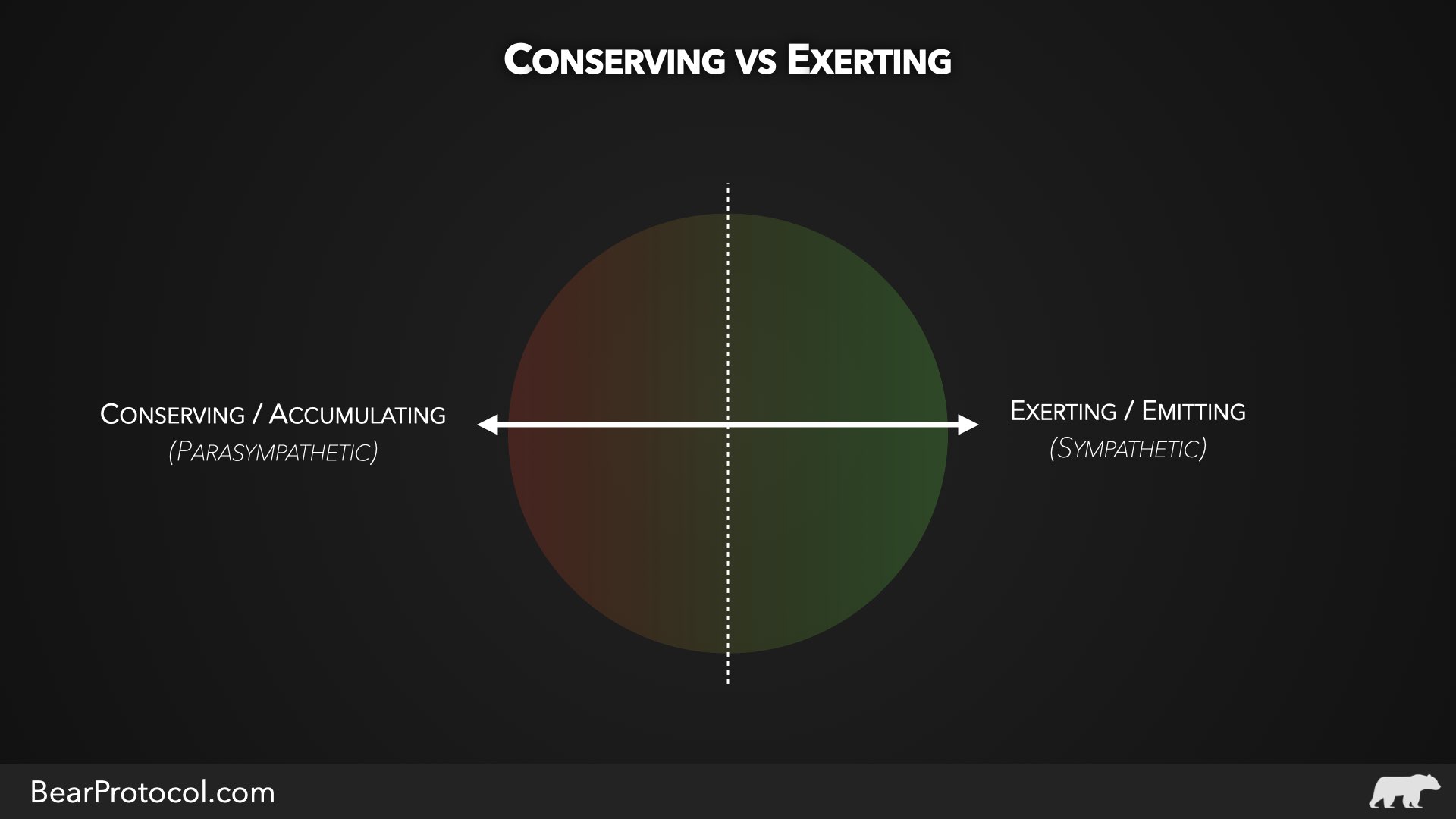
When you put the 4 basic nervous system states on a quadrant broken down by conserving vs exerting and surviving vs thriving – it looks like this:
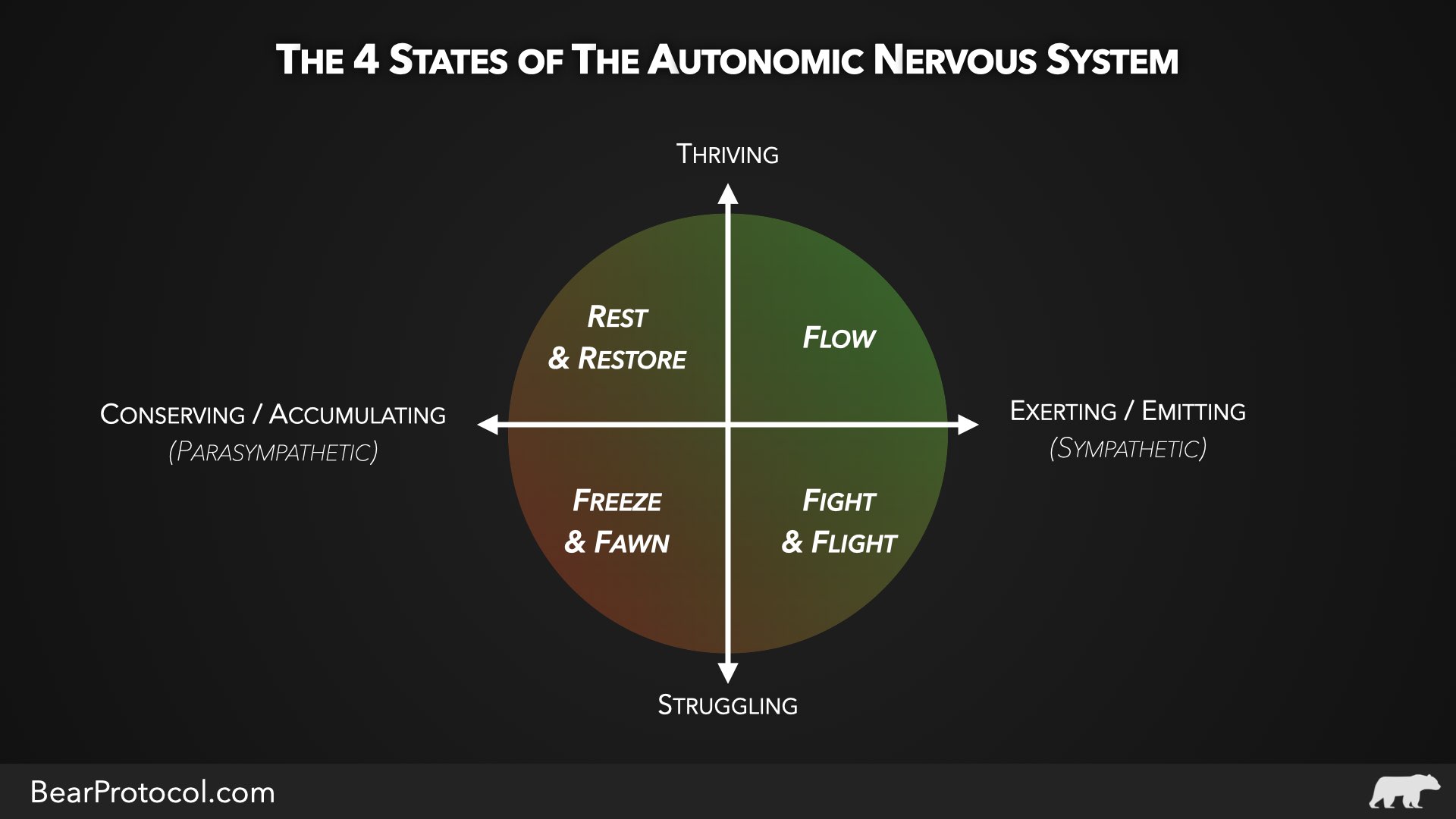
Note that although the parasympathetic nervous system is mostly known as the “good” rest and digest nervous system state and the sympathetic nervous system is mostly known as the “bad” fight and flight nervous system state – that is not fully accurate. The parasympathetic (conserving nervous system) and the sympathetic (exerting nervous system) both play roles in good “thriving” times and bad “survival” times.
The Sequence of Nervous System Healing and Recovery
Freeze and Fawn: The Lowest Nervous System State
The lowest nervous system state is the “freeze” state, sometimes referred to as the freeze or fawn state. This is the state of the nervous system when the sensations of sight, sound, and feeling are overwhelming and beyond the capacity of the body to deal with. This overwhelm of stress is called trauma and triggers a shutdown called freeze.
For a good example of the freeze state let’s take an imaginary trip to the Sahara and consider the response of a young lion cub getting chased by a pack of hyenas. At first, the cub is just in a state of fight and flight but as the hyenas grab ahold of the cub with their teeth, the overwhelming sensations trigger the freeze response and the poor little cub becomes shut down and frozen.
In this case, it’s very nice that the freeze response has kicked in because it numbs the little cub to the horrific experience that is likely to follow.
Like the cub, when people are faced with overwhelming trauma they can also become shut down and frozen. This physiology is not chosen but a response of the autonomic nervous system. Alternatively, sometimes people do not become physically frozen but enter a ‘fawning’ state where they do their best to blend in and not draw attention to themselves. This is also a survival state not too dissimilar to a reptile that camouflages itself to avoid drawing any extra attention to itself.
Fight and Flight: The Second Phase of Neurohealing and Health
To understand the full sequence of nervous system healing we’ll return to the story of the lion cub. The little cub’s nervous system is in its lowest and most shutdown state. And just when the fate of the poor cub is to be sealed, his big bother from the pride comes running full speed into the scene. His big brother frightens the hyenas, who are forced to drop the cub to turn their attention to the bigger lion. The little cub’s glossed-over eyes make out the view of his brother and his ears hear his bigger brother’s roar. These sights and sounds together with feeling the release of the teeth of the hyenas, are the sensations the nervous system of the cub needs to move from the shutdown freeze state to a state of action and high energy – the fight and flight.
It’s important to note that the transition from shutdown or freeze to activity and fight and flight is also an automatic response and not a conscious choice. The reason this automatic response occurs is because of the removal of the sensation of defeat (the teeth clenched around its neck) and the sights, and sounds of an older brother who provides a feeling of hopefulness. When the body goes from feeling hopeless to hopeful it moves from a frozen physiology to a state of action. This is still a survival state but it is the survival response of the ‘exerting’ sympathetic system, rather than the survival response of the ‘conserving’ parasympathetic system.
Rest and Restore: The Third State Of Neurohealth and Recovery
The good news is that the little cub, with a helpful burst of adrenaline and energy, makes it back to the pride with his bigger brother. The cub is exhausted from testing the limits of his cardiovascular and respiratory systems. He finds a shady spot under the protection of a few small trees. There he tremors and shakes off the remaining stress hormones and by doing so downregulates the survival states of the nervous system. He now lies there resting. This is the beginning of the rest and restore phase. The young cub is aware of his body’s desire to rest rather than go and play with his buddies. He might also nap. Maybe his mother brings him some food. After his energy and resources are fully restored his nervous system enters the fourth phase.
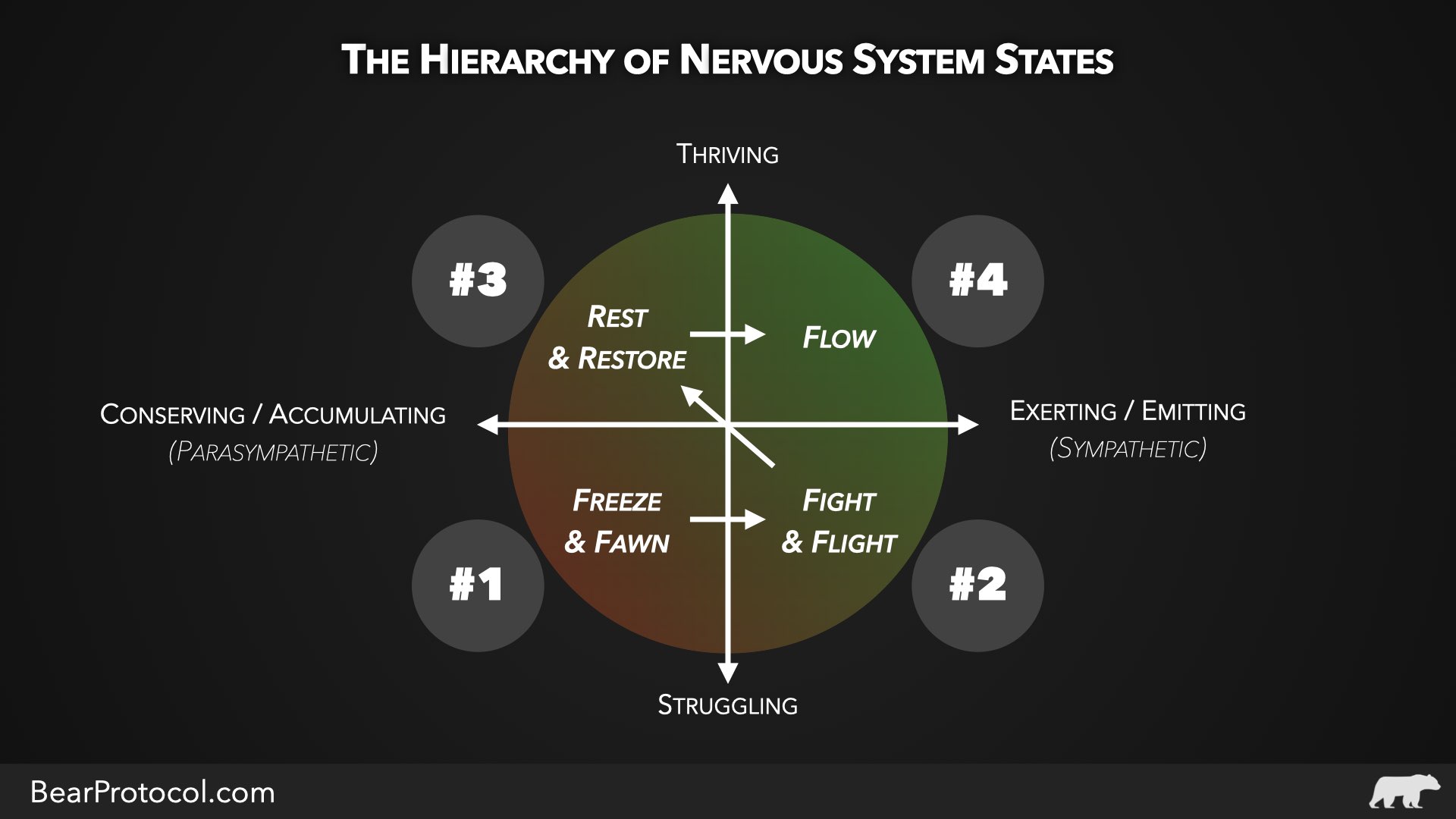
Flow
Flow is a thriving state of the sympathetic nervous system. It’s a state where the body exerts or uses its energy supply but not in reaction to a threat, stress, or danger. This energy and exertion is used for progress, development or in the case of the cub, healing and repair.
It’s interesting to note that when people get to this state where the inner power of healing is activated and works its wonders, not only does one experience accelerated physical healing, but it is often accompanied by other characteristics often associated with ‘flow’ states. This can include feeling motivated, inspired, focused, connected, enlightened and elevated spiritual experiences. I’m not sure the cub in the story experienced all of that but it’s not uncommon for physical healing to be paired with spiritual and emotional healing and vice versa.
Braking, Accelerating, Coasting, and Cruising
In summary, the four nervous system states could be thought of as braking (freeze), accelerating (fight and flight), coasting (rest and restore) and cruising (flow). Each plays an important role but you don’t want to get stuck in any of them. And in the case of healing, you want to move as quickly as possible out of the survival states (fight, flight, freeze or fawn) and into states where you rest, restore resources, and finally use those resources to heal and detox the body as needed.
The 4 Phases of Cellular Healing and Nervous System Healing Are Not Independent of One Another
It is VERY important to understand that the nervous system states of the body and the cellular states of the cell are not independent of each other. Emotional stress (and its accompanying shift in the nervous system and physiology) can burden the cell and trigger the cell danger response. Likewise, when cells shift into a cell danger response from exposure to a physical burden (for example a moldy building or toxic air) it can trigger the nervous system to drop into a stress response and a survival state.
You can think of the nervous system as the macroeconomy (how the economy is doing as a whole) and the cells as an individual business within that economy (a microeconomy). The small business (a cell) is impacted by the broader macroeconomy (the nervous system) but at the same rate, the macroeconomy (the nervous system) is impacted by the collection of small businesses (the cells).
You Will Feel Physiological Changes When You Shift From One Phase of Healing to the Next
Because the nervous system and cells work together it is not unusual to feel the body’s physiology change from one state of healing to the next. One of the most noticeable differences from one phase of healing to the next is how energized you feel.
Note that both cells and the nervous system move from conserving energy to exerting energy twice.
It looks like this.
Energy in the nervous system sequence:
- Freeze/Fawn: Conserving energy while waiting for a chance to escape or fight.
- Fight/Flight: Exerting energy to escape danger and return to safety.
- Rest/Restore: Conserving energy while restocking lost resources and reserves.
- Flow/Healing: Exerting energy to heal any wounds or injuries.
Energy in the cellular sequence:
- Cell Danger Response 1: Conserving until the threat is contained.
- Cell Danger Response 2: Exerting energy to build more and better mitochondria.
- Cell Danger Response 3a: Conserving energy while accumulating necessary capacity.
- Cell Danger Response 3b: Exerting energy to heal/remodel and detox the cells.

But energy isn’t the only shift you can feel.
There are changes you can feel that precede or even trigger shifting from one phase of healing to the next. These include shifting from hopelessness to hope, from hope to safety and security, from safety and security to feeling rested, energized and extroverted, and from energized to fulfilled and joyful.
These signals will be noticed by those in tune with their bodies and they are valuable insights into how we ought to change our diets, lifestyle and resting/sleep to support our body’s process of healing.
So let’s revisit our table of the 4 phases of healing. This time the table is expanded to include key items of nervous system healing in addition to cellular healing.
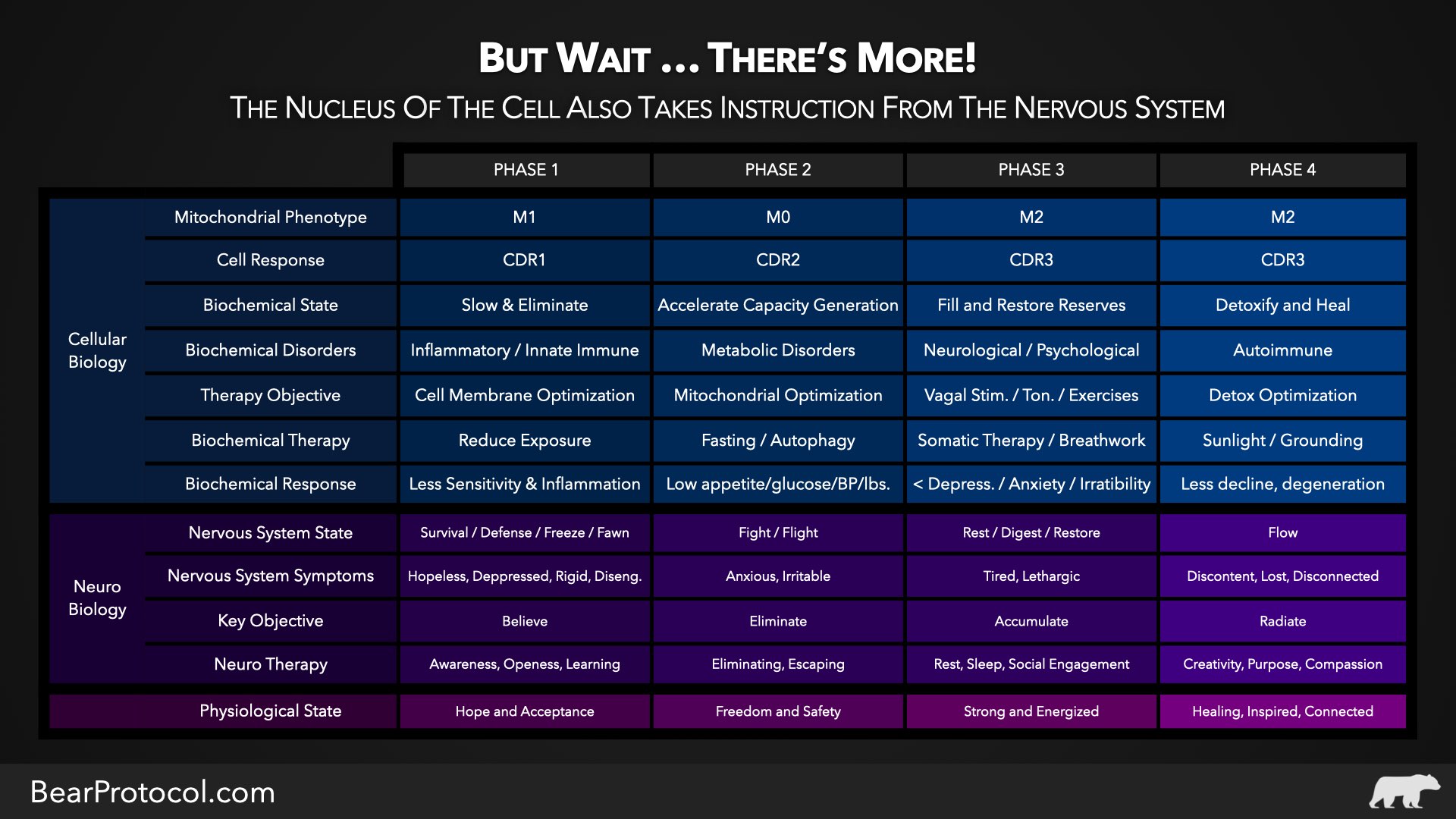
The Speed of Healing is Limited by the Availability of Nutrients
So there you go! That’s the sequence of healing on the micro (cellular) level and the macro (nervous system) level.
What could go wrong?
Well, there is a third and critical piece that’s necessary to complete the healing.
Nutrients.
The truth is – healing can only occur at the rate at which the needed nutrients are available.
For example, cells can only create new membranes at the rate the materials for new cell membranes (phospholipids) are made available.
or
Inflammation can only be resolved at the rate resolvins (compounds that resolve inflammation) and the nutrients needed to make said resolvins (DHA, EPA, and AA) are made available.
And the list goes on and on. The important thing to remember is insufficient nutrients can slow or even halt the healing process. On the other hand, ensuring an abundance of the nutrients needed for each phase of healing can accelerate the process.
The Bear Diet is built to ensure an abundance of all nutrients needed for healing. It’s worth noting that while there are only a few dozen “essential” nutrients that the body cannot make on its own – there are many other nutrients that are “conditionally essential” – meaning that the body cannot create enough of them in a state of stress, injury or sickness.
It should also be noted that the nutrients needed in one phase of healing are not the exact nutrients needed in another phase. And so in The Bear Protocol, we emphasize the nutrients needed to move through the current phase. This is addressed in greater detail in further articles but for now know that we focus on emphasizing nutrients for cell membrane synthesis, mitochondrial genesis, neurotransmitter synthesis, hydration, nerve function, mitochondrial function and detoxification each in their time and place.
Let’s Put it All Together
Let’s summarize the main points of healing we’ve discussed here.
#1 Both cells and the nervous system must all move through their 4 respective states of healing. These two main players are dependent on each other to move through the phases of healing.
#2 The 4 steps of healing must be done in order! Each phase is contingent on the resolution of the prior phases.
#3 Healing can only occur at the rate at which the necessary nutrients are available.
Feel free to use this graphic as a reference of the players and phases of the healing sequence.

There Are 12 Critical Steps To Support and Optimize The Healing of the Cells and Nervous System
You don’t need to understand all that’s going on during the healing cycle.
You should, however, make the effort to understand what you need to do in order to move through the healing process.
The 12 items that MUST BE ADDRESSED are highlighted below in color. The other items in this table are simply there for reference or convenience.

The Cheatsheet For The 12 Steps of The Bear Protocol
Also, for your reference or as helpful consider an expanded graphic of the 12 parts or ways in which you can support and optimize the four phases of healing.

